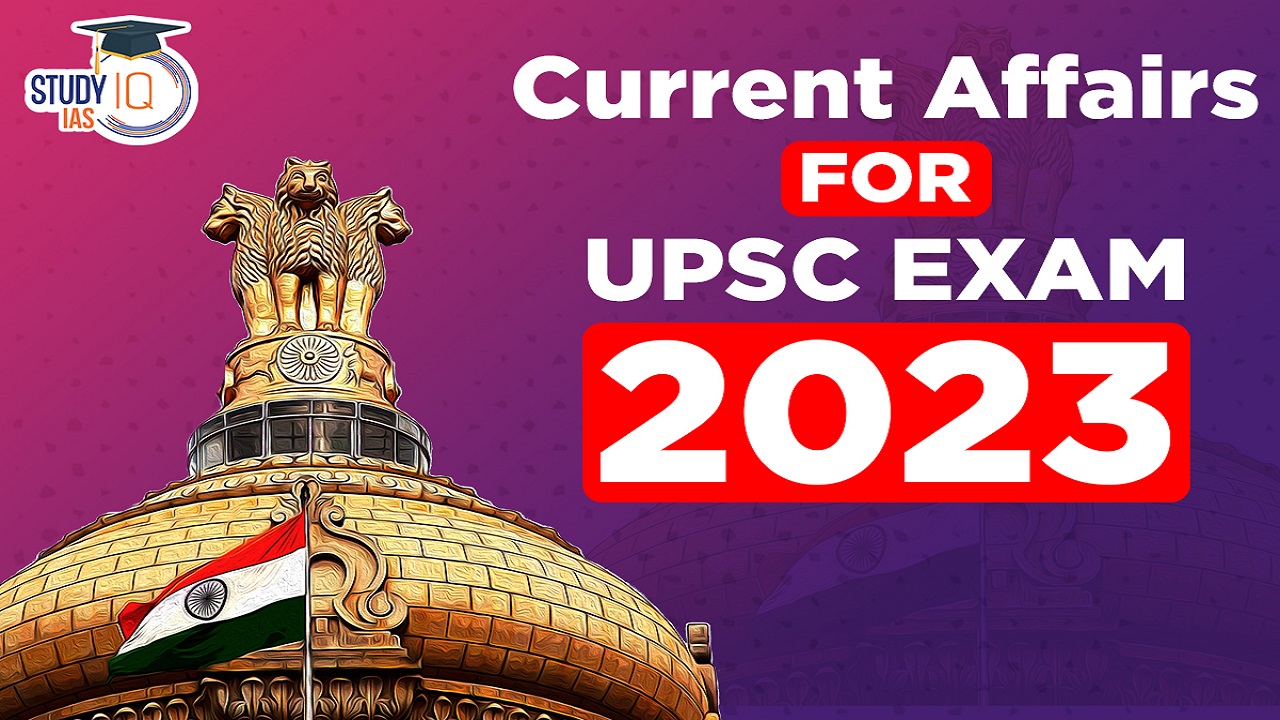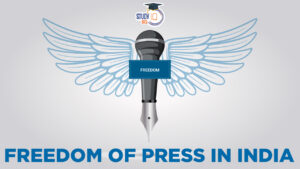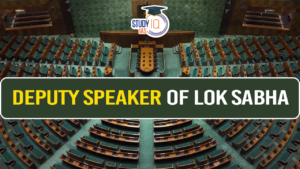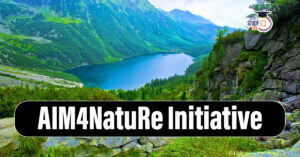Current Affairs 9th May 2023 for UPSC Prelims Exam
Legislative Council
Context: Recently, Election Commission announced by-polls to the two vacant Uttar Pradesh Legislative Council seats.
About Legislative Council
- It is the Upper House in a bicameral state legislature with the lower house being the State Legislative Assembly.
- Article 169 (Creation and Abolition): The Parliament can create or abolish a Legislative Council by a simple majority, if the legislative assembly of the concerned state, by a special majority, passes a resolution to that effect.
- Composition: Under Article 171 of the Constitution, the Legislative Council of a state shall not have more than one-third of the total strength of the State Assembly, and not less than 40 members.
- It is a continuing chamber, that is, it is a permanent body and is not subject to dissolution.
- Tenure: Six years, with one-third of the members retiring every two years.
- Eligibility: Must be a citizen of India.
- Must be not less than 30 years of age.
- Must possess other qualifications prescribed by the Parliament.
- A person to be elected to the Legislative Council must be an elector for an assembly constituency in the concerned state and to be qualified for governor’s nomination, he must be a resident in the concerned state.
- Manner of Election: One-third of the MLCs are elected by the state’s MLAs,
- Another 1/3rd by a special electorate comprising sitting members of local governments such as municipalities and district boards,
- 1/12th by an electorate of teachers and another 1/12th by registered graduates.
- The remaining members are appointed by the Governor for distinguished services in various fields namely, literature, science, art, cooperative movement and social service.
- Role of Legislative Council: It can ensure individuals who might not be cut out for the elections are able to contribute to the legislative process (like artists, scientists, etc).
- It can keep an eye on hasty decisions taken by the Legislative Assembly.
- States with Legislative Council: Andhra Pradesh, Telangana, Uttar Pradesh, Bihar, Maharashtra, Karnataka.

Current Affairs 8th May 2023 for UPSC Prelims Exam
Metastasis
Context: Researchers from Texas Tech University developed a deep learning model to classify cancer cells by type.
- Cancer cells that initiate metastasis or the spread of the disease from its primary location.
- Distinguishing metastasis-initiating cell types can determine the severity of cancer and help medical practitioners decide on a course of treatment.
About Metastasis
- Metastasis is the general term used to describe the spread of cancer cells from the primary tumor to surrounding tissues and to distant organs and is the primary cause of cancer morbidity and mortality.
- In metastasis, cancer cells break away from the original (primary) tumor, travel through the blood or lymph system, and form a new tumor in other organs or tissues of the body.
- The new, metastatic tumor is the same type of cancer as the primary tumor. For example, if breast cancer spreads to the lung, the cancer cells in the lung are breast cancer cells, not lung cancer cells.
- Metastasis involves a series of sequential and interrelated steps.
- In order to complete the metastatic cascade, cancer cells must detach from the primary tumor, intravasate into the circulatory and lymphatic systems, evade immune attack, extravasate at distant capillary beds, and invade and proliferate in distant organs.
- Metastatic cells also establish a microenvironment that facilitates angiogenesis and proliferation, resulting in macroscopic, malignant secondary tumors.

Kali Tiger Reserve (KTR)
Context: NTCA (National Tiger Conservation Authority) has taken cognisance of illegal resort in the Castle Rock Wildlife Range of the Kali Tiger Reserve (KTR).
About Kali Tiger Reserve (KTR)
- Location: It is located in Uttara Kannada District of Karnataka State.
- The Tiger Reserve comprises of two important protected areas of the region viz., Dandeli Wildlife Sanctuary and Anshi National Park.
- In 2007, both Anshi National Park and the Dandeli Wildlife Sanctuary together have been declared as Dandeli-Anshi tiger reserve.
- They are contiguous to each other and form a single tract of protected area located in biologically sensitive Western Ghats.
- Kali River flows through the tiger reserve hence the name Kali Tiger Reserve.
- Vegetation: Forests are primarily moist deciduous and semi-evergreen, with excellent patches of evergreen forests in the westernmost parts as well as in deep valleys.
- Fauna: It is known for housing many tigers, black panthers and elephants.
- Other large mammals here are Indian bison, sloth bear, Indian wild boar, bonnet macaque, northern plains gray langur, gray slender loris, several deer including: barking deer (muntjac), mouse deer (chevrotain), sambar deer and spotted deer (chital or axis deer).

MiG-21
Context: Recently, an Indian Air Force (IAF) MiG-21 crashed in Rajasthan’s Hanumangarh district.
About MiG-21
- The MiG-21 is India’s longest-serving fighter plane.
- India got its first single-engine MiG-21 in 1963, and since then it has inducted over 800 variants of the Soviet-origin supersonic fighters to bolster its combat potential.
- It remained the frontline fighter jet of the force for a long time.
- The MiG-21 Bison version:
- The MiG-21 Bison was the upgraded version of the MiG-21bis which was first inducted into service in 1976.
- The first upgrade of Bison version was received 2001 and the last of these upgraded fighters was received in 2008.
- Flying coffins:
- The MiG-21 aircrafts were dubbed as ‘flying coffins’ for their dismissive flying record and high number of pilot casualties.
- In the last 60 years, more than 200 pilots and 60 civilians have lost their lives in these crashes.
- Majority of the MiG-21 were licence-produced in India.
- Currently, the IAF has around 70 MiG-21 aircraft and 50 MiG-29 variants.
- IAF has drawn up a three-year plan to phase out all the four remaining squadrons of MiG-21s by 2025.
- It also plans to retire the MiG-29 fleet and the process will start in next five years.
Thalassaemia
Context: May 8 marks World Thalassaemia Day, which is a special day dedicated to raising awareness about a genetic disorder called Thalassaemia.
About Thalassaemia
- Thalassaemia is a genetic-blood disorder that requires people to have regular blood transfusions mostly throughout the span of their life.
- Thalassaemia is part of a group of disorders called hemoglobinopathies.
- Hemoglobinopathies are a group of disorders that are passed down through families (inherited) in which there is abnormal production or structure of haemoglobin molecules.
- Thalassaemia, Hemophilia and Sickle Cell Disorder all come under the umbrella of hemoglobinopathies.
- Causes: Thalassaemia is caused by mutations in the genes that control the production of hemoglobin. These mutations can be inherited from one or both parents who carry the mutated genes.
- Symptoms: Mild cases may have no symptoms or mild anemia, while severe cases can cause life-threatening complications such as heart failure and organ damage.
- Common symptoms of Thalassaemia include fatigue, weakness, pale skin, jaundice, and delayed growth and development in children.
- Types of Thalassaemia: There are two main types of Thalassaemia:
- Alpha Thalassaemia: occurs when there is a mutation in one or more of the four alpha globin genes,
- Beta Thalassaemia: occurs when there is a mutation in one or both of the two beta globin genes.
- Treatment: Mild cases may not require any treatment, while severe cases may require regular blood transfusions, iron chelation therapy to remove excess iron from the body, and bone marrow transplants.
- Symptomatic treatment may also be used to manage complications such as anemia, infections, and organ damage.
- Prevention: Thalassaemia is a genetic disorder, so there is no way to prevent it. However, genetic counseling and testing can help identify carriers of the mutated genes and guide family planning decisions.
Prevalence of Thalassaemia in India
- According to the data from the Ministry of Health and Family Welfare, every year, 10,000 to 15,000 children are born with B-Thalassaemia major and make use of transfusion.
- The Health Ministry also highlighted that there are 42 million carriers of the Thalassaemia trait in India.
- Thalassaemia trait carriers are those people who don’t have the disorder but carry a gene that can become a disorder in their offspring if their partner is a Thalassaemia carrier as well.
Government efforts Thalassaemia in India
- The Government of India has been working on Thalassaemia prevention and management.
- The National Health Mission has come up with guidelines for the prevention and management of hemoglobinopathies.
- The mission is to improve the care of Thalassaemia and Sickle Cell Disease patients and reduce the prevalence of hemoglobinopathies through screening and awareness strategies.
- Community education and awareness programs, sustainable carrier screening programs, premarital and pre-conception screening, and extended family screening are all part of the strategy.
Social egg freezing and Assisted Reproductive Technology (ART)
Context: Indian women in their 30s are increasingly opting for social egg-freezing, a form of assisted reproductive technology (ART), where eggs are stored until a woman is ready to give birth.
What is Social egg freezing?
- Social egg freezing, also known as elective or non-medical egg freezing, is a procedure where a woman’s eggs are retrieved, frozen, and stored for later use.
- This procedure is done for non-medical reasons, such as delaying childbearing to pursue career or personal goals, or to preserve fertility before undergoing medical treatments that may affect fertility.
How social egg freezing is done?
- Social egg freezing involves a process called ovarian stimulation, where the woman takes medication to encourage the ovaries to produce multiple eggs.
- The eggs are then retrieved through a minimally invasive procedure called transvaginal ultrasound-guided follicular aspiration, where a needle is inserted into the ovaries to retrieve the eggs.
- The retrieved eggs are then frozen and stored in a cryopreservation facility until the woman is ready to use them.
What are the benefits of social egg freezing?
- It gives women the opportunity to preserve their fertility and have children later in life, without having to worry about age-related decline in fertility.
- It also allows women to prioritize their career or personal goals without sacrificing their fertility.
- However, it is important to note that social egg freezing is not a guarantee of future pregnancy, as success rates may vary depending on a variety of factors, such as age and the number of eggs retrieved.
What is Assisted Reproductive Technology (ART)?
- The Assisted Reproductive Technology (Regulation) [ART] Act, 2021 defines ART to include all techniques that seek to obtain a pregnancy by handling the sperm or the oocyte (immature egg cell) outside the human body and transferring the gamete or the embryo into the reproductive system of a woman.
- Examples of ART services include gamete (sperm or oocyte) donation, in-vitro-fertilization (fertilizing an egg in the lab), and gestational surrogacy (the child is not biologically related to the surrogate mother).
- ART services will be provided through:
- ART clinics, which offer ART related treatments and procedures, and
- ART banks, which store and supply gametes.
Key provisions of the Assisted Reproductive Technology (Regulation) [ART] Act, 2021
| Regulation of ART clinics and banks | The act provides that every ART clinic and the bank must be registered under ICMR’s National Registry of Banks and Clinics of India.
The National Registry will act as a central database with details of all ART clinics and banks in the country. |
| Conditions for gamete donation and supply | Screening of gamete donors, collection and storage of semen and provision of oocyte donors can only be done by a registered ART bank.
A bank can obtain semen from males between 21 and 55 years of age, and oocytes from females between 23 and 35 years of age. An oocyte donor should be a married woman having at least one alive child of her own (minimum three years of age). The woman can donate oocytes only once in her life and not more than seven oocytes can be retrieved from her. A bank cannot supply the gamete of a single donor to more than one couple seeking services. |
| Conditions for offering ART services | ART procedures can only be carried out with the written informed consent of both the party seeking ART services as well as the donor.
The party seeking ART services will be required to provide insurance coverage in the favour of the oocyte donor (for any loss, damage, or death of the donor). A clinic is prohibited from offering to provide a child of pre-determined sex. The act also requires checking for genetic diseases before embryo implantation. |
| Rights of a child born through ART | A child born through ART will be deemed to be a biological child of the couple (commission couple) and will be entitled to the rights and privileges available to a natural child of the commissioning couple.
A donor will not have any parental rights over the child. |
| National and State Boards | The act provides that the National and State Boards for Surrogacy constituted under the Surrogacy (Regulation) Act, 2021 will act as the National and State Board respectively for the regulation of ART services. |
Respiratory Syncytial Virus (RSV)
Context: The Food and Drug Administration (FDA) has approved the vaccine ‘Arexvy’ for respiratory syncytial virus (RSV).
Key Details:
- ‘Arexvy’ is the first RSV vaccine to be approved anywhere in the world. The approval was based on a phase-3 trial carried out on nearly 25,000 participants.
Efficacy:
- It showed a single dose of the vaccine reduced the risk of developing lower respiratory tract disease caused by the RSV virus by 82.6% and severe disease by 94.1% in people older than 60 years.
| About respiratory syncytial virus (RSV): | |
| What is RSV? | Respiratory syncytial virus (RSV) is a seasonal virus that can cause mild to severe respiratory illness, especially in young children and older adults. |
| Transmission | RSV spreads through respiratory secretions, such as from coughing or sneezing, or by touching contaminated surfaces. |
| Symptoms | RSV can cause symptoms such as coughing, wheezing, fever, runny nose, and difficulty breathing. It may lead to bronchitis and pneumonia. |
| Vulnerability | Infants, older adults, and people with weakened immune systems are most at risk for severe RSV infection. |
| Diagnosis | RSV can be diagnosed through a respiratory sample, such as from a nasal or throat swab, that is tested in a laboratory. |
| Treatment | Treatment for RSV is mainly supportive, such as with fluids, oxygen therapy, and fever reducers. Severe cases may require hospitalization. |
- RSV in India: According to the research, the annual incidence rate in India is 53 per 1,000 children (5.3%), with an estimated 61,86,500 cases of RSV associated with acute lower respiratory infection in children under the age of five. RSV killed 97 percent of children under the age of five in low- and middle-income nations.


 Freedom of Press in India, Constitutiona...
Freedom of Press in India, Constitutiona...
 Deputy Speaker of Lok Sabha, Constitutio...
Deputy Speaker of Lok Sabha, Constitutio...
 AIM4NatuRe Initiative for Nature Restora...
AIM4NatuRe Initiative for Nature Restora...





















